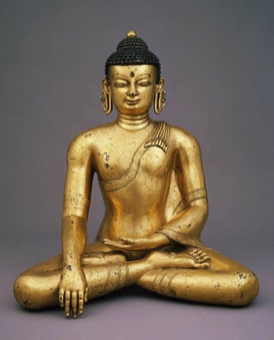
Shakyamuni Buddha
According to Buddhist belief, enlightenment is a state in which one comes to understand the true nature of reality and is released from the endless cycle of birth and rebirth that defines earthly existence.
Buddhism teaches that anyone is capable of achieving enlightenment and, therefore, can become a Buddha, which simply means “Enlightened One.” There are thirty-two major and eight minor physical characteristics associated with the enlightened being. The statue seen here is marked by several of these features, including the ushnisha, or cranial protuberance on top of his head, and the urna, the mark between his eyebrows, both symbols of wisdom. Although such signs indicate that the Buddha is somehow different and special, he nonetheless maintains distinctly human form. The statue, thus, reminds the Buddhist practitioner that enlightenment is always within reach.
Because Buddhism allows for many enlightened beings and not just one, artistic conventions developed to help distinguish between them. This Buddha, for example, is identifiable by his posture and hand gestures (called mudras) as Shakyamuni, the Historical Buddha. According to legend, Shakyamuni was born Siddhartha, heir to a kingdom in the Himalayan foothills. When he was still a relatively a young man, Siddhartha renounced his privileged position and the material wealth that went with it. After several years of living as an ascetic, however, he concluded that attempting to overcome human suffering and desire through self-denial and force of will was an exercise in futility. At that time, he sat down beneath a tree, where he meditated until he had achieved a state of enlightenment. It is this moment in the Buddha’s life that the sculpture references.
Shakyamuni is depicted here in a meditative pose. His legs are crossed in the lotus position and his right hand rests palm up in his lap. With the fingertips of his left hand, he touches the ground, a gesture that refers to his summoning of the Earth Goddess in response to attempts by the demon Mara to disrupt his meditation. Shakyamuni called on the goddess to bear witness to his right to achieve enlightenment, which she did, enabling him to triumph over his antagonist and attain Buddhahood.

